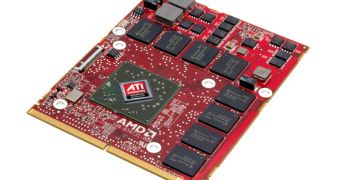We reported a few days ago that Advanced Micro Devices had unleashed into the wild a couple of next-generation ATI Mobility Radeon HD cards that have been manufactured under the 40-nanometer process technology. The new models mark two important steps for the giant manufacturer. First of all, the chip maker is the first to step into the 40nm technology, this being the fifth time when it manages to advance ahead of competition to a new process node, and secondly, this is the first time when the move to the new fabrication is made in the mobile computer market.
We didn't have too much time to look closer at the new parts before, yet now we have the chance to provide more details on the new ATI Mobility Radeon HD 4860 and ATI Mobility Radeon HD 4830 graphics cards. For the beginning, we should say one thing that most of you might already be aware of: the smaller die of the new cards allows computer makers to include smaller mobile machines with more graphics power, while also providing users with more power efficiency.
In addition, the goodies that one can enjoy with the company's desktop series are also available in the new 40nm mobile graphics cards, including the award-winning TeraScale engine, the ATI Avivo HD technology and the Unified Video Decoder. In addition, the new cards also include power-saving technologies such as ATI PowerPlay, ATI PowerXpress, and ATI Switchable Graphics, which are meant to leverage the battery life of your mobile machine.
When it comes to the specification list of the new 40nm graphics solutions, there are little differences between the two that can be spotted. The ATI Mobility Radeon HD 4860 GPU comes with 640 stream processors and features a core clock set at 650MHz. Its memory clock goes up to 4.0 Gbps, while the card is able to deliver up to 832 Gflops of compute power. For even more performance, AMD decided to pack the new card with GDDR5 video memory, with a 128-bit memory interface.
In comparison to HD 4860, the new ATI Mobility Radeon HD 4830 comes with a 450MHz/600MHz core clock speed, and GDDR3/DDR3 memory clocked at 800 MHz - 900 MHz, and it is able to deliver 512 GFlops - 768 GFlops compute power. Both cards feature dual integrated DisplayPort, HDMI with 7.1 Surround Sound, as well as support for ATI CrossFireX technology.
The performance levels the new cards are able to deliver can not be contested by anyone. Whether it is about the latest game titles that need a lot of resources when it comes to graphics, or HD multimedia content, the new ATI Mobility Radeon HD 4860 and ATI Mobility Radeon HD 4830 manufactured under the 40-nanometer process technology are there, ready to be put to good use.
So far there are no notebooks to include the new cards, yet they are expected to surface pretty soon, during the second quarter of the ongoing year. For the time being, we already reported that the new ASUS K Series notebooks that are present on the floor of the CeBIT 2009 show in Hanover, Germany would come with the new ATI Mobility Radeon HD 4860 and HD 4830 graphics cards. Until the laptops become available on the market, take a look at the video below to see how the cards perform.

 14 DAY TRIAL //
14 DAY TRIAL //